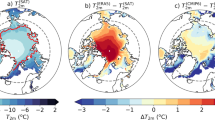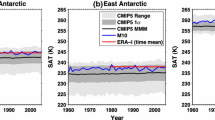Abstract
Strong relationships exist between the Southern Annular Mode (SAM) and surface air temperature (SAT) across much of Antarctica. Changes in the SAM will have a profound influence on future Antarctic climate so it is important that the models used to predict climate change can accurately reproduce current SAM–SAT relationships. We analyse data from 50 Climate Model Intercomparison Project (CMIP) 5 models to assess how well they reproduce the observed mean and variability of annual and seasonal SAM–SAT relationships at six Antarctic stations. Overall, the models do better at reproducing these relationships when meridional flow has its largest influence on SAT, doing best (worst) in winter (autumn and summer). They are generally unable to replicate existing seasonal cycles in the strength of the SAM–SAT relationship and show much less spatial and especially temporal variability in the strength of these relationships than is observed. Using an estimate of intrinsic variability to quantify the skill of the CMIP5 models, their average ability to successfully replicate a seasonal SAM–SAT relationship at the six locations studied ranges from 16 % in autumn to 32 % in winter. The mean success rate of a single model across all four seasons is 24 %, ranging from 8 to 38 % (compared to a ‘perfect model’ with 46 %). Analysing the different atmospheric circulation patterns associated with extreme SAM–SAT correlations in the models demonstrates the importance of correctly reproducing both the climatological mean and variability of the planetary longwaves at Southern Hemisphere high-latitudes (particularly wave-number 3), in order to accurately reproduce observed SAM–SAT relationships across Antarctica.















Similar content being viewed by others
References
Allen MR, Smith LA (1996) Monte Carlo SSA: detecting irregular oscillations in the presence of colored noise. J Clim 9:3373–3404
Arblaster JM, Meehl GA (2006) Contributions of external forcings to Southern Annular Mode trends. J Clim 19:2896–2905
Arblaster JM, Meehl GA, Karoly DJ (2011) Future climate change in the Southern Hemisphere: competing effects of ozone and greenhouse gases. Geophys Res Lett 38. doi:10.1029/2010GL045384
Bracegirdle TJ, Marshall GJ (2012) The reliability of Antarctic tropospheric pressure and temperature in the latest global reanalyses. J Clim 25:7138–7146
Bracegirdle TJ, Stephenson DB (2012) Higher precision estimates of regional polar warming by ensemble regression of climate model projections. Clim Dyn 39:2805–2821
Bromwich DH, Nicolas JP, Monaghan AJ (2011) An assessment of precipitation changes over Antarctica and the Southern Ocean since 1989 in contemporary global reanalyses. J Clim 24:4189–4209
Brown MB, Forsythe AB (1974) Robust tests for the equality of variances. J Am Stat Assoc 69:364–367
Clem KR, Fogt RL (2013) Varying roles of ENSO and SAM on the Antarctic Peninsula climate in austral spring. J Geophys Res 118:11481–11492
Connolley WM (1997) Variability in annual mean circulation in southern high latitudes. Clim Dyn 13:745–756
Dee DP et al (2011) The ERA-Interim reanalysis: configuration and performance of the data assimilation scheme. Q J R Meteorol Soc 137:553–597
Ding Q, Steig EJ, Battisti DS, Küttel M (2011) Winter warming in West Antarctica caused by central tropical Pacific warming. Nat Geosci 4:398–403
Fogt RL, Bromwich DH (2006) Decadal variability of the ENSO teleconnection to the high-latitude South Pacific governed by coupling with the Southern Annular Mode. J Clim 19:979–997
Fogt RL, Perlwitz J, Monaghan AJ, Bromwich DH, Jones JM, Marshall GJ (2009) Historical SAM variability. Part II: twentieth-century variability and trends from reconstructions, observations, and the IPCC AR4 models. J Clim 22:5346–5365
Fogt RL, Jones JM, Renwick J (2012a) Seasonal zonal asymmetries in the Southern Annular Mode and their impact on regional temperature anomalies. J Clim 25:6253–6270
Fogt RL, Wovrosh AJ, Langen A, Simmonds I (2012b) The characteristic variability and connection to the underlying synoptic activity of the Amundsen–Bellingshausen Seas low. J Geophys Res 117. doi:10.1029/2011JD017337
Gillett NP, Fyfe JC (2013) Annular mode changes in the CMIP5 simulations. Geophys Res Lett 40:1189–1193
Gong D, Wang S (1999) Definition of Antarctic oscillation index. Geophys Res Lett 26:459–462
Ho M, Kiem AS, Verdon-Kidd DC (2012) The Southern Annular Mode: a comparison of indices. Hydrol Earth Syst Sci 16:967–982
Hosking JS, Orr A, Marshall GJ, Turner J, Phillips T (2013) The influence of the Amundsen–Bellingshausen Seas low on the climate of West Antarctica and its representation in coupled climate model simulations. J Clim 26:6633–6648
Jones JM, Fogt RL, Widmann M, Marshall GJ, Jones PD, Visbeck M (2009) Historical SAM variability. Part I: century length seasonal reconstructions. J Clim 22:5319–5345
Knutti R, Masson D, Gettelman A (2013) Climate model genealogy: generation CMIP5 and how we got there. Geophys Res Lett 40:1194–1199
Kwok R, Comiso JC (2002) Spatial patterns of variability in Antarctic surface temperature: connections to the Southern Hemisphere Annular Mode and the Southern Oscillation. Geophys Res Lett 29. doi:10.1029/2002GL015415
Li X, Holland DM, Gerber EP, Yoo C (2014) Impacts of the north and tropical Atlantic Ocean on the Antarctic Peninsula and sea ice. Nature 505:538–542
Liu S, Wang HJ (2013) Transition of zonal asymmetry of the Arctic Oscillation and the Antarctic Oscillation at the end of the 1970s. Adv Atmos Sci 30:41–47
Marshall GJ (2003) Trends in the Southern Annular Mode from observations and reanalyses. J Clim 16:4134–4143
Marshall GJ (2007) Half-century seasonal relationships between the Southern Annular Mode and Antarctic temperatures. Int J Climatol 27:373–383
Marshall GJ, Orr A, van Lipzig NPM, King JC (2006) The impact of a changing Southern Hemisphere Annular Mode on Antarctic Peninsula summer temperatures. J Clim 19:5388–5404
Marshall GJ, Di Battista S, Naik SS, Thamban M (2011) Analysis of a regional change in the sign of the SAM–temperature relationship in Antarctica. Clim Dyn 36:277–287
Marshall GJ, Orr A, Turner J (2013) A predominant reversal in the relationship between the SAM and East Antarctic temperatures during the twenty-first century. J Clim 26:5196–5204
Miller RL, Schmidt GA, Shindell DT (2006) Forced annular variations in the 20th century intergovernmental panel on climate change fourth assessment report models. J Geophys Res 111. doi:10.1029/2005JD006323
Nicolas JP, Bromwich DH (2011) Climate of West Antarctica and influence of marine air intrusions. J Clim 24:49–67
Parish TR, Bromwich DH (1998) A case study of Antarctic wind interaction with large-scale forcing. Mon Weather Rev 126:199–209
Parish TR, Cassaon JJ, Seefeldt MW (2006) Characteristics of the Ross Ice Shelf air stream as depicted in Antarctic Mesoscale Prediction System simulations. J Geophys Res 111. doi:10.1029/2005JD006185
Polvani LM, Previdi M, Derser C (2011a) Large cancellation, due to ozone recovery, of future Southern Hemisphere atmospheric circulation trends. Geophys Res Lett 38. doi:10.1029/2011GL046712
Polvani LM, Waugh DW, Correa GJP, Son S-W (2011b) Stratospheric ozone depletion: the main driver of twentieth-century atmospheric circulation changes in the Southern Hemisphere. J Clim 24:795–812
Previdi M, Smith KL, Polvani LM (2013) The Antarctic atmospheric energy budget. Part I: climatology and intraseasonal-to-interannual variability. J Clim 26:6406–6418
Raphael MN (2007) The influence of atmospheric zonal wave three on Antarctic sea ice variability. J Geophys Res 112. doi:10.1029/2006JD007852
Schneider DP, Okumura Y, Deser C (2012) Observed Antarctic interannual climate variability and tropical linkages. J Clim 25:4048–4066
Sen Gupta A, England MH (2006) Coupled ocean–atmosphere–ice response to variations in the Southern Annular Mode. J Clim 19:4457–4486
Silvestri G, Vera C (2009) Nonstationary impacts of the Southern Annular Mode on Southern Hemisphere climate. J Clim 22:6142–6148
Taylor KE, Stouffer RJ, Meehl GA (2012) An over view of CMIP5 experiment design. Bull Am Meteorol Soc 93:485–498
Thompson DWJ, Solomon S (2002) Interpretation of recent Southern Hemisphere climate change. Science 296:895–899
Thompson DWJ, Solomon S, Kushner PJ, England MH, Grise KM, Karoly DJ (2009) Signatures of the Antarctic ozone hole in Southern Hemisphere surface climate change. Nat Geosci 4:741–749
Turner J, Colwell SR, Marshall GJ, Lachlan-Cope TA, Carleton AM, Jones PD, Lagun V, Reid PA, Iagovkina S (2004) The SCAR READER project: toward a high-quality database of mean Antarctic meteorological observations. Int J Climatol 17:2890–2898
van den Broeke MR, van Lipzig NPM (2003) Response of wintertime Antarctic temperatures to the Antarctic Oscillation: results of a regional climate model. In: Domack E, Leventer A, Burnett A, Bindschadler R, Convey P, Kirby M (eds) Antarctic Peninsula climate variability: historical and paleoenvironmental perspectives, Ant Res Ser 79. AGU, Washington, pp 43–58
van Lipzig NPM, Marshall GJ, Orr A, King JC (2008) The relationship between the Southern Hemisphere Annular Mode and Antarctic Peninsula summer temperatures: analysis of a high-resolution model climatology. J Clim 21:1649–1668
Zheng F, Li J, Clark RT, Nnamchi HC (2013) Simulation and projection of the Southern Hemisphere annular mode in CMIP5 models. J Clim 26:9860–9879
Acknowledgments
We thank the reviewers for their constructive comments that helped improve the final manuscript. This work was supported by the UK Natural Environment Research Council through the British Antarctic Survey research programme Polar Science for Planet Earth.
Author information
Authors and Affiliations
Corresponding author
Rights and permissions
About this article
Cite this article
Marshall, G.J., Bracegirdle, T.J. An examination of the relationship between the Southern Annular Mode and Antarctic surface air temperatures in the CMIP5 historical runs. Clim Dyn 45, 1513–1535 (2015). https://doi.org/10.1007/s00382-014-2406-z
Received:
Accepted:
Published:
Issue Date:
DOI: https://doi.org/10.1007/s00382-014-2406-z




